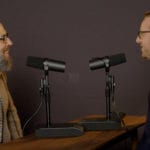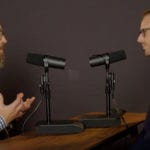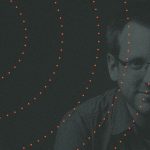In this interview, Tim Challies and Stephen McCaskell discuss their new book and documentary, Epic: An Around-the-World Journey through Christian History (April, 2020). Developed for both individuals and groups, the book and film work hand-in-hand to help you discover the 33 fascinating objects that tell the history of Christianity. Learn more at EpicChristianHistory.com.
How did this project come about?
Tim Challies: Years ago I mapped out a series of articles that would attempt to tell the history of Christianity by examining key historical objects. I even wrote quite a lot of the material. And, while I found the process of research and writing interesting enough, I always felt like an element was missing. Only a few years later did it occur to me—the missing element was actually seeing the objects. I decided to re-examine the project to see what would be involved in actually doing that kind of travel. I soon realized it would be an incredible project, but also one that would be far beyond my means. Yet just a day after I came to that conclusion, a stranger got in touch with me to ask if he could speak with me about money. He represents a group of businessmen who posed me with this question: Has there ever been a project you’ve wanted to do but have not been able to because money has been the object? Their generosity soon got me on my way!
Stephen McCaskell: Three years ago I pulled into a rest stop nestled in between the mountains that separate Bakersfield and LA. I had received an email from Tim asking me to give him a call to talk about his camera and audio setup for videos he had started producing. During the conversation we discussed upcoming projects we were both working on. He mentioned an ambitious project he had just started where he was traveling the world in the hunt for objects through which he could tell the story of Christian history. I responded telling him how compelling and neat it would be if I followed him around with a camera as he traveled the world. It was just a handful of months later and we were off to Israel on our first trip together. The first time we ever met was in the airport on our way to Tel Aviv.
Why did the two of you choose to work on this together?
SM: I had just finished releasing Luther: The Life and Legacy of the German Reformer and was discerning what I’d work on next. I’ve always been interested in church history, so when I had an opportunity to work with Tim, it really was a no brainer. It also doesn’t hurt that we’re both Canadian and share a love for coffee.
TC: As for me, I had dreamed up a project that involved only a book, but when Stephen got in touch, I quickly saw the promise of a documentary.
What were a couple of your favorite moments?
SM: Trekking through Hezekiah’s tunnel was unforgettable. Our first journey took us to Israel, and in Old Jersualem, underneath the City of David, is a water channel carved from ancient times. Most people suggest it dates back to the time of King Hezekiah when he was preparing for the city to be attacked but wanted to ensure a fresh flow of water into the city. The tunnel is pitch black for more than 580 yards (it takes about 20 to 25 minutes to get through) with varying amounts of water and humidity. Not for the feint of heart or those that are even slightly claustrophobic!
So many moments stand out to me, from Tim breaking his arm in Ireland, having a nap on the couch William Carey died on, spending time with the kids at Faith Children’s Village in Zambia, seeing the ministry Amy Carmichael built in southern India, and so much more. While the project is about the hunt for historical objects, one thing I’ll never forget is all of the people we met.
TC: I echo was Stephen says that the most unexpected joy was meeting Christians from all around the world. In their own way, they proved that history is alive. We traveled the world to follow the path the gospel has taken over the centuries, and were immeasurably blessed to see how the gospel has taken root in the lives of people from all parts of the globe. Beyond that, my favorite moment was perhaps exploring the Bay of Islands in New Zealand—the place where the first missionaries landed and immediately began to preach. It is a large park in an isolated location, and we had it pretty much to ourselves. It was quiet, it was deserted, and it was hauntingly beautiful. It was not difficult to pause and imagine some of the great events that had taken place in that very spot.
What’s one particularly quirky object?
TC: Andrew Fuller’s snuff box is a favorite. As I explain in the book and film, it was an object I had read about and wanted to track down, because this little snuff box was used to collect the first funds for the Baptist Missionary Society. It belonged to Andrew Fuller, a friend of William Carey, and as soon as they founded this new missions organization for “the propagation of the gospel to the heathens,” they passed the snuff box around the room so each man present could provide a donation. The few pounds they collected that day were the seed from which the modern missions movement grew—and by which God’s people changed the world. I had been assured by some prominent Christian historians that it had been lost to history. But while scouring Carey’s archives I received a tip and was soon able to find it. It was a wonderful moment.
Why did you choose to base the project around objects?
TC: History is, of course, the study of the past. Objects existed in the past, but continue to exist in the present, and in that way
they provide a link between then and now. While we always have to engage our imaginations to understand and describe history, objects can serve as an important kind of aid. It is one thing to think about George Müller carrying out his lifelong work of caring for orphans, but another to sit at his desk and open his Bible and read, “Pure religion and undefiled before God and the Father is this, To visit the fatherless and widows in their affliction, and to keep himself unspotted from the world” (James 1:27). While we don’t venerate those objects or attach any spiritual power to them, we can still use them to help us better understand what God has done and ultimately, to bring glory to God.
What journey was most difficult to make?
SM: I had only been to India once before, and it was just to the capital, Delhi. This time we landed in Delhi but then took a plane to the very far east of India to visit Serampore College, which the great Baptist missionary William Carey founded. From there we went back to Delhi and then proceeded to the far south of India to visit Dohnavur Fellowship, the ministry founded by Amy Carmichael. By the end of our eight-day trip we had been on eight planes. There’s really no place in the world like India. It’s full of color, kind people, and rich Christian history. But it was a difficult journey!
TC: I agree with Stephen that the journey to and through India was the most difficult. That said, we did almost unbelievably well with our travels. We missed only one connection through the entire project, and even then we just rented a car and made up for it quickly. People who said they would meet us invariably met us; planes were mostly on time; hotels were waiting for us; and we stayed healthy (except for one moderately broken arm).
Learn more at EpicChristianHistory.com.
Is there enough evidence for us to believe the Gospels?
 In an age of faith deconstruction and skepticism about the Bible’s authority, it’s common to hear claims that the Gospels are unreliable propaganda. And if the Gospels are shown to be historically unreliable, the whole foundation of Christianity begins to crumble.
In an age of faith deconstruction and skepticism about the Bible’s authority, it’s common to hear claims that the Gospels are unreliable propaganda. And if the Gospels are shown to be historically unreliable, the whole foundation of Christianity begins to crumble.



































